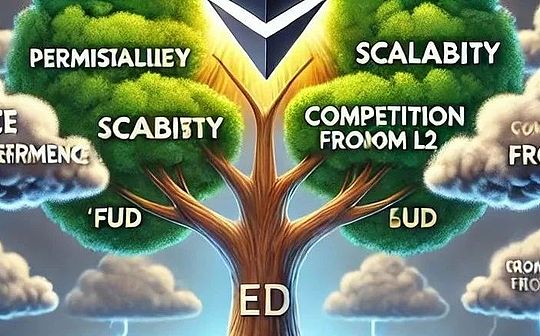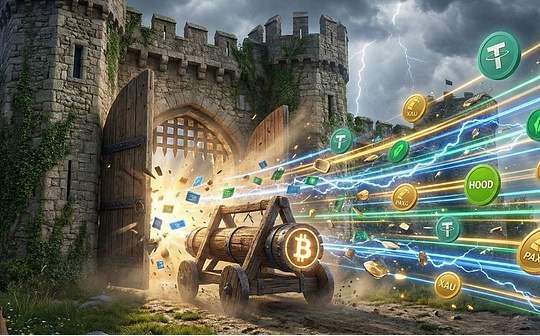
Source: Lightning HSL
Since the 85 plunge, there has been bad news on ETH every day on x, all kinds of FUDs.The most typical categories:
1.sol is going to defeat Ethereum.
2.L2 reduces the commercial value of ETH.
3. There is no innovation in the ether.
4. Wall Street only blows btc, not eth.
Actually, I think that all these FUDs do not touch the root of a blockchain, or these criticisms do not touch on the key points, but only talk about some details or speculations without solid reasons.
I still think that the Ethereum blockchain is very healthy, but its price performance is lagging behind the expectations of most investors.
To evaluate whether a chain is good, the most important thing is the three key points that cryptocurrency and blockchain promise to users:
1. Decentralization
2. No permission required
3. Scalable
Currently, many chains have been evaluated, and these three things have been achieved, and only Ethereum has been passed through production practice.
We can evaluate the degree of decentralization of a chain from multiple dimensions.
The first is to evaluate whether there is power to truly force the shutdown or kill a chain.
The most awesome thing about this is Bitcoin. The law enforcement forces forced the shutdown of a large number of mining pools and mines in a very short time, but the operation of Bitcoin was completely normal.Ethereum also experienced a similar impact at that time, but now Ethereum has changed from PoW to PoS.
At present, it is hard to imagine any power to turn off Ethereum.However, I think it is difficult to close most of the chains, which is the feature of blockchain.
Secondly, we can evaluate whether the mining nodes of the production block of the chain are decentralized.
Ethereum’s PoS mining often breaks out that it is too centralized, especially Lido’s mining pool accounts for too much share, but it does not exceed 30%, which is completely safe at the algorithm level.
Mining, which has commercial pursuits, is often centralized due to its demand for efficiency.In fact, Bitcoin’s current mining pool is far more centralized than Ethereum, and there should be only 4 mining pools that are completely independent of Bitcoin.
Mining centralization is a difficult problem that almost all chains have to face, but Ethereum is now the best thing to do in the head chains.
Another factor in decentralization is whether developers are centralized.
The power of blockchain node software developers is very high because the code they write is the rules for chain operation.If it is a centralized development team, controlled by mysterious forces, and directly embedded the stolen code in the code, that’s all.
Ethereum’s current node software is divided into two parts: execution layer and consensus layer, which is very complex. When the beacon chain was just running, I think this thing is so complicated that there may not be many teams on Earth who can maintain and develop the complete Ethereum node.Bar.
But now it seems that in Ethereum, where business value is so great, many commercial companies parasitize their business on the Ethereum chain, and naturally have multiple independent complete nodes.There are four more mature applications now, instead of relying on the Ethereum Foundation’s direct development team.
Ethereum is the most successful in all links in the development and maintenance of the full nodes.More successful than BTC.
I feel that the many users and investors of Ethereum may have completely misunderstood the degree of decentralization of Ethereum.Now on x.com, people often pray to God V, hoping that God V will come out to work and advise God V not to sell coins.
This is not the performance that a decentralized community should have.Decentralized blockchains do not need God, nor should they have God.These users who pray to V God should go to stock trading, because the stock world has central nodes that can pray.
Whether it can maintain permissionlessness is the real challenge for current blockchain and cryptocurrencies.
Because almost all users in the currency circle have registered an exchange and have been KYC, the exchange holds a large amount of coins, and the exchanges are subject to supervision, especially the United States.
Even the Treasury Office of Overseas Assets Control (OFAC) manages a list of “Specially Designated Nationals and Blocked Personnel Lists”, which OFAC will add individuals and entities suspected of engaging in illegal activities.This list contains some encrypted digital currency addresses and some IPs.
As for the Earth and IP on this list, other companies will not dare to provide services to them, including unpackaged and related transactions.
Various institutions in the currency circle, such as exchanges, mining pools, wallets, block browsers… After Binance accepted the penalty, I felt that as long as I could find a responsible person in charge, I would be connected to this list, that is,It may be difficult to use Bitcoin for people, addresses, and IPs on the list.
It is said that the mining pools of Bitcoin and Ethereum are now connected to this list.
This is the biggest threat to the lack of permission.
There is also the Tornado project, which was blacklisted by the exchange. Whenever the address of tornado washing coins has been used, some transactions will refuse to provide services, and even directly ban the relevant accounts.
But as of now, Ethereum has not required permission and is still maintained.At least we can see that tornados can still be used. This thing is really decentralized and has been banned from operating by a certain US government department, but it can still be used.
But now it is increasingly challenging.
Nowadays, many projects on the Ethereum ecosystem have begun to review users, especially stablecoins such as usdt and usdc, including Dai, which has also had a blacklist after upgrading to USDS.This is not a good trend.
In general, in terms of horizontal evaluation, Ethereum is relatively best in terms of permissionlessness. After all, its economic ecosystem is the most prosperous and hidden in the market.If you want to find faults without permission, I think it is the hardest to pick Ethereum.
As for technically powerful figures like Monero, because their economic ecology is too poor, they are actually not very practical incapable of permissionlessness.
Finally, expandable.
With the support of Rollup, Ethereum has completely solved the scalability problem.
In the past, the Ethernet chain was really full load and could only process 15 transactions in one second.
Now considering the transactions in Rollup, it is estimated that the TPS (upper limit for packaged transactions per second) of the entire Ethereum system has exceeded 1,000.arbitrum ran more than 100 tps during actual operation.
Although many critics say that L1 sharding is better than L1+L2 for expansion solutions, those sharding technology chains, such as MultiversX, have not been verified in the actual production environment.BCH developers also claim to be completing the Adaptive Blocksize Limit Algorithm upgrade. BCH has also solved the scalability problem, but this still does not accept actual production challenges.
As the scalability of blockchain is necessary, the only way to challenge its scalability is to be challenged by the way of using a long and real diversity of transaction volumes to challenge its scalability.
Sol has accepted the challenge, but has indeed failed many times.
The price performance is not good.
Perhaps, in the context of the ETF year, prices will mainly rely on the pursuit and recognition of Wall Street institutions in a short period of time, and these financial institutions on Wall Street may not care about decentralization, license-free and scalable features..








